Developing Professional Practice Report: HR Activities and Reflection
VerifiedAdded on 2023/04/08
|14
|2776
|149
Report
AI Summary
This report provides a comprehensive overview of HR professional practice, drawing on the CIPD framework and real-world applications within the Providence Company. It begins by evaluating the role of an HR professional, highlighting key skills such as people practice, culture and behavior, business acumen, and digital working. The report then delves into group dynamics, outlining the stages of group development and providing examples of conflict resolution methods, including collaborative and accommodating approaches. Furthermore, it examines project management techniques, such as Gantt charts and the critical path method, used in projects like salary renewals and office fit-outs. Finally, the report discusses problem-solving techniques, specifically root cause analysis, to address performance issues and improve decision-making. Overall, the report offers a practical guide to HR practices, emphasizing the importance of skills and strategies for effective HR management and organizational success.
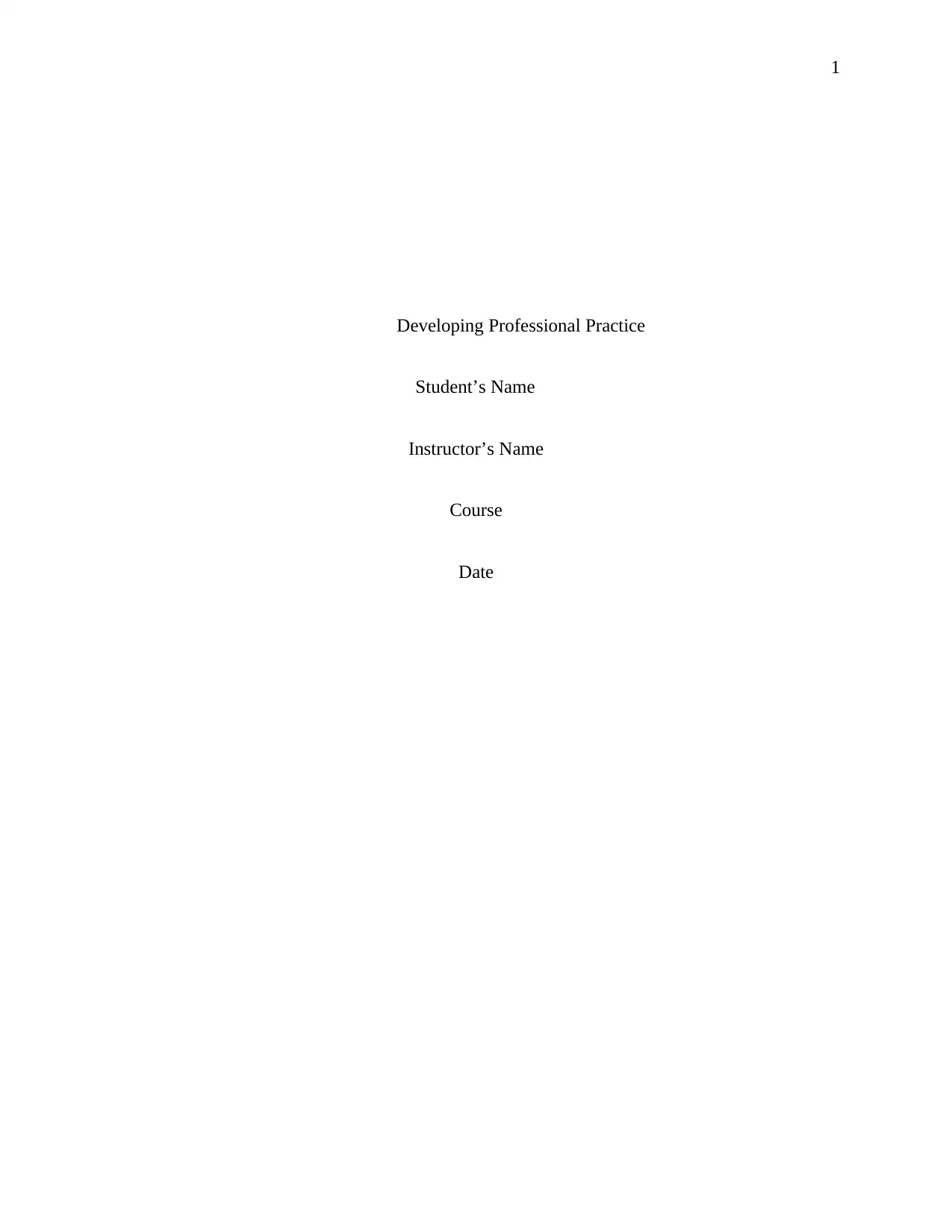
1
Developing Professional Practice
Student’s Name
Instructor’s Name
Course
Date
Developing Professional Practice
Student’s Name
Instructor’s Name
Course
Date
Paraphrase This Document
Need a fresh take? Get an instant paraphrase of this document with our AI Paraphraser
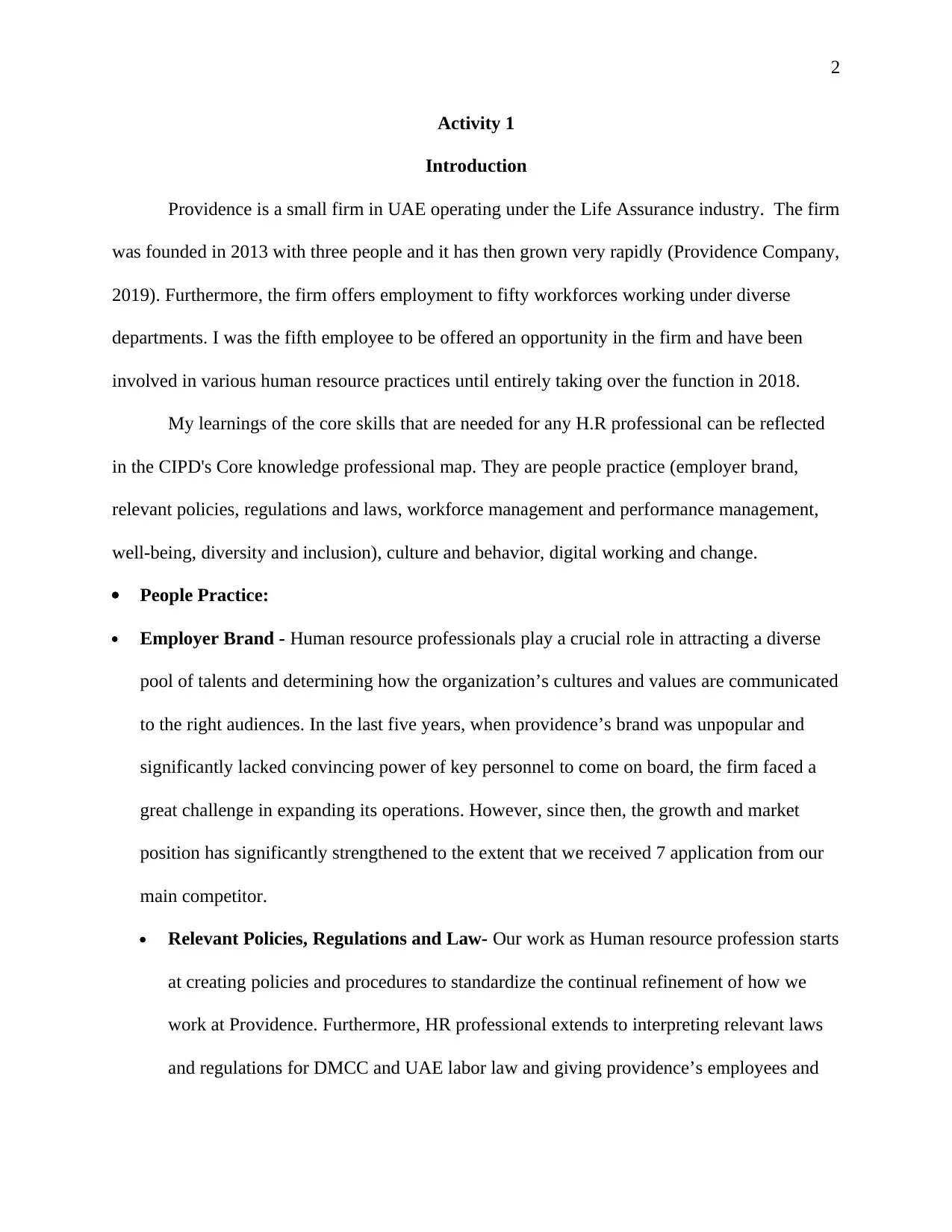
2
Activity 1
Introduction
Providence is a small firm in UAE operating under the Life Assurance industry. The firm
was founded in 2013 with three people and it has then grown very rapidly (Providence Company,
2019). Furthermore, the firm offers employment to fifty workforces working under diverse
departments. I was the fifth employee to be offered an opportunity in the firm and have been
involved in various human resource practices until entirely taking over the function in 2018.
My learnings of the core skills that are needed for any H.R professional can be reflected
in the CIPD's Core knowledge professional map. They are people practice (employer brand,
relevant policies, regulations and laws, workforce management and performance management,
well-being, diversity and inclusion), culture and behavior, digital working and change.
People Practice:
Employer Brand - Human resource professionals play a crucial role in attracting a diverse
pool of talents and determining how the organization’s cultures and values are communicated
to the right audiences. In the last five years, when providence’s brand was unpopular and
significantly lacked convincing power of key personnel to come on board, the firm faced a
great challenge in expanding its operations. However, since then, the growth and market
position has significantly strengthened to the extent that we received 7 application from our
main competitor.
Relevant Policies, Regulations and Law- Our work as Human resource profession starts
at creating policies and procedures to standardize the continual refinement of how we
work at Providence. Furthermore, HR professional extends to interpreting relevant laws
and regulations for DMCC and UAE labor law and giving providence’s employees and
Activity 1
Introduction
Providence is a small firm in UAE operating under the Life Assurance industry. The firm
was founded in 2013 with three people and it has then grown very rapidly (Providence Company,
2019). Furthermore, the firm offers employment to fifty workforces working under diverse
departments. I was the fifth employee to be offered an opportunity in the firm and have been
involved in various human resource practices until entirely taking over the function in 2018.
My learnings of the core skills that are needed for any H.R professional can be reflected
in the CIPD's Core knowledge professional map. They are people practice (employer brand,
relevant policies, regulations and laws, workforce management and performance management,
well-being, diversity and inclusion), culture and behavior, digital working and change.
People Practice:
Employer Brand - Human resource professionals play a crucial role in attracting a diverse
pool of talents and determining how the organization’s cultures and values are communicated
to the right audiences. In the last five years, when providence’s brand was unpopular and
significantly lacked convincing power of key personnel to come on board, the firm faced a
great challenge in expanding its operations. However, since then, the growth and market
position has significantly strengthened to the extent that we received 7 application from our
main competitor.
Relevant Policies, Regulations and Law- Our work as Human resource profession starts
at creating policies and procedures to standardize the continual refinement of how we
work at Providence. Furthermore, HR professional extends to interpreting relevant laws
and regulations for DMCC and UAE labor law and giving providence’s employees and
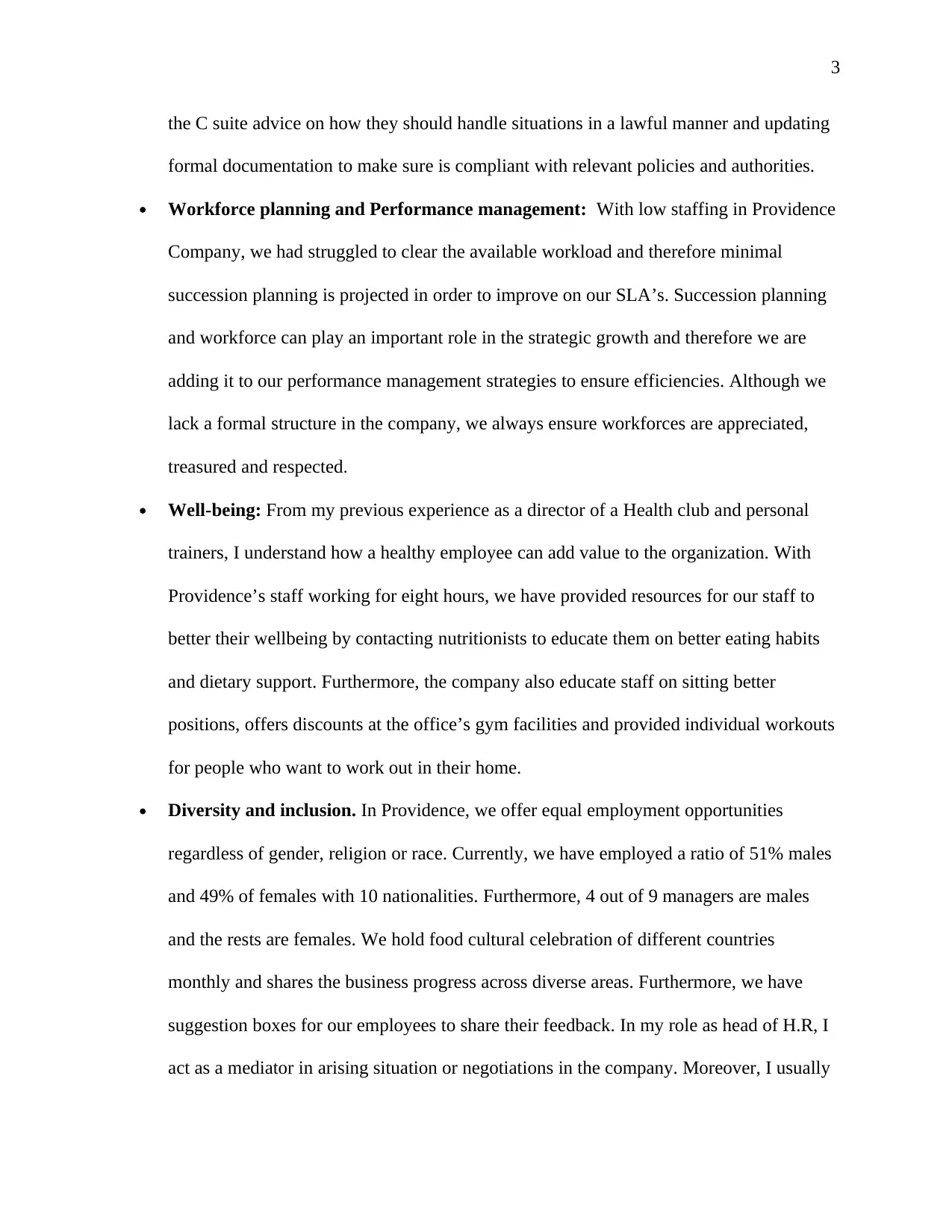
3
the C suite advice on how they should handle situations in a lawful manner and updating
formal documentation to make sure is compliant with relevant policies and authorities.
Workforce planning and Performance management: With low staffing in Providence
Company, we had struggled to clear the available workload and therefore minimal
succession planning is projected in order to improve on our SLA’s. Succession planning
and workforce can play an important role in the strategic growth and therefore we are
adding it to our performance management strategies to ensure efficiencies. Although we
lack a formal structure in the company, we always ensure workforces are appreciated,
treasured and respected.
Well-being: From my previous experience as a director of a Health club and personal
trainers, I understand how a healthy employee can add value to the organization. With
Providence’s staff working for eight hours, we have provided resources for our staff to
better their wellbeing by contacting nutritionists to educate them on better eating habits
and dietary support. Furthermore, the company also educate staff on sitting better
positions, offers discounts at the office’s gym facilities and provided individual workouts
for people who want to work out in their home.
Diversity and inclusion. In Providence, we offer equal employment opportunities
regardless of gender, religion or race. Currently, we have employed a ratio of 51% males
and 49% of females with 10 nationalities. Furthermore, 4 out of 9 managers are males
and the rests are females. We hold food cultural celebration of different countries
monthly and shares the business progress across diverse areas. Furthermore, we have
suggestion boxes for our employees to share their feedback. In my role as head of H.R, I
act as a mediator in arising situation or negotiations in the company. Moreover, I usually
the C suite advice on how they should handle situations in a lawful manner and updating
formal documentation to make sure is compliant with relevant policies and authorities.
Workforce planning and Performance management: With low staffing in Providence
Company, we had struggled to clear the available workload and therefore minimal
succession planning is projected in order to improve on our SLA’s. Succession planning
and workforce can play an important role in the strategic growth and therefore we are
adding it to our performance management strategies to ensure efficiencies. Although we
lack a formal structure in the company, we always ensure workforces are appreciated,
treasured and respected.
Well-being: From my previous experience as a director of a Health club and personal
trainers, I understand how a healthy employee can add value to the organization. With
Providence’s staff working for eight hours, we have provided resources for our staff to
better their wellbeing by contacting nutritionists to educate them on better eating habits
and dietary support. Furthermore, the company also educate staff on sitting better
positions, offers discounts at the office’s gym facilities and provided individual workouts
for people who want to work out in their home.
Diversity and inclusion. In Providence, we offer equal employment opportunities
regardless of gender, religion or race. Currently, we have employed a ratio of 51% males
and 49% of females with 10 nationalities. Furthermore, 4 out of 9 managers are males
and the rests are females. We hold food cultural celebration of different countries
monthly and shares the business progress across diverse areas. Furthermore, we have
suggestion boxes for our employees to share their feedback. In my role as head of H.R, I
act as a mediator in arising situation or negotiations in the company. Moreover, I usually
⊘ This is a preview!⊘
Do you want full access?
Subscribe today to unlock all pages.

Trusted by 1+ million students worldwide
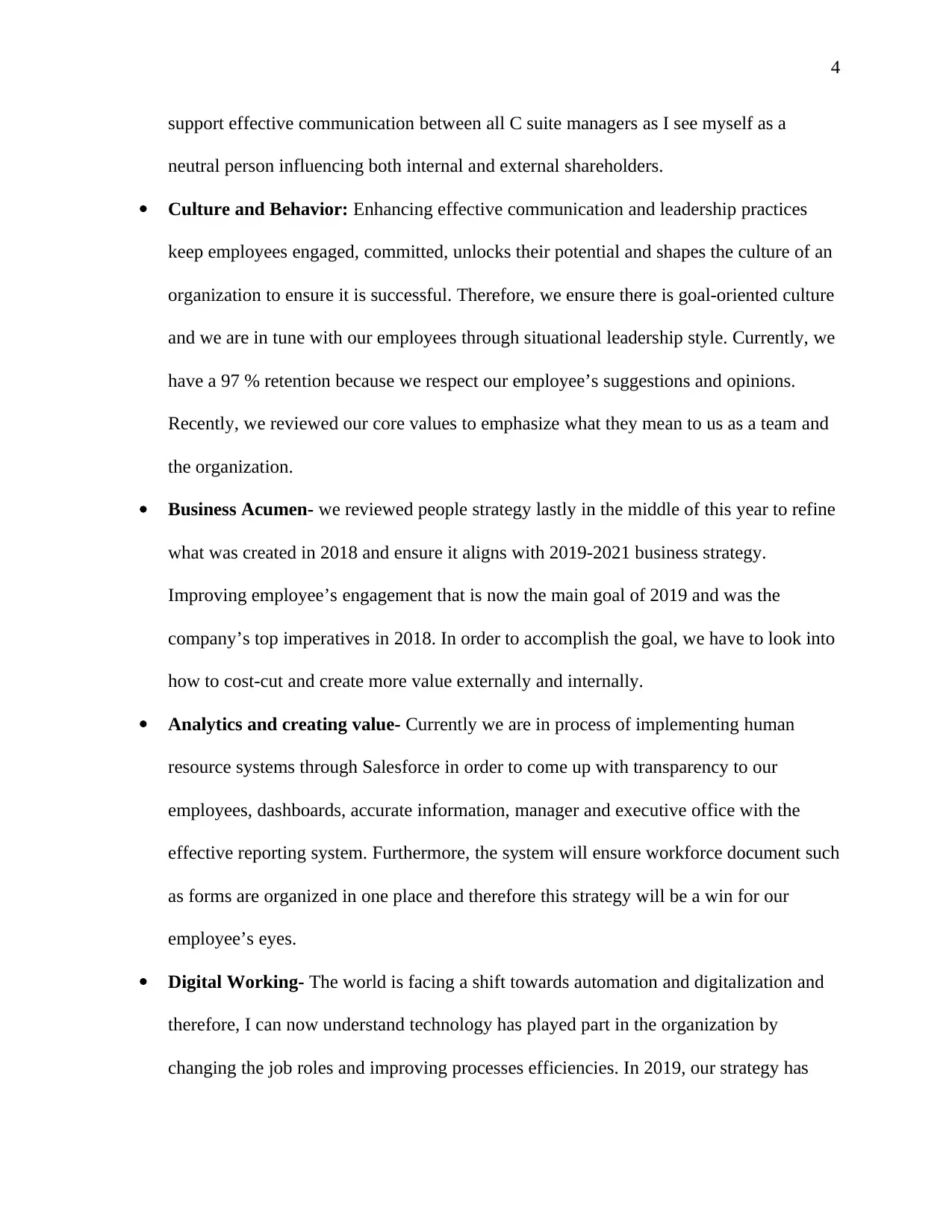
4
support effective communication between all C suite managers as I see myself as a
neutral person influencing both internal and external shareholders.
Culture and Behavior: Enhancing effective communication and leadership practices
keep employees engaged, committed, unlocks their potential and shapes the culture of an
organization to ensure it is successful. Therefore, we ensure there is goal-oriented culture
and we are in tune with our employees through situational leadership style. Currently, we
have a 97 % retention because we respect our employee’s suggestions and opinions.
Recently, we reviewed our core values to emphasize what they mean to us as a team and
the organization.
Business Acumen- we reviewed people strategy lastly in the middle of this year to refine
what was created in 2018 and ensure it aligns with 2019-2021 business strategy.
Improving employee’s engagement that is now the main goal of 2019 and was the
company’s top imperatives in 2018. In order to accomplish the goal, we have to look into
how to cost-cut and create more value externally and internally.
Analytics and creating value- Currently we are in process of implementing human
resource systems through Salesforce in order to come up with transparency to our
employees, dashboards, accurate information, manager and executive office with the
effective reporting system. Furthermore, the system will ensure workforce document such
as forms are organized in one place and therefore this strategy will be a win for our
employee’s eyes.
Digital Working- The world is facing a shift towards automation and digitalization and
therefore, I can now understand technology has played part in the organization by
changing the job roles and improving processes efficiencies. In 2019, our strategy has
support effective communication between all C suite managers as I see myself as a
neutral person influencing both internal and external shareholders.
Culture and Behavior: Enhancing effective communication and leadership practices
keep employees engaged, committed, unlocks their potential and shapes the culture of an
organization to ensure it is successful. Therefore, we ensure there is goal-oriented culture
and we are in tune with our employees through situational leadership style. Currently, we
have a 97 % retention because we respect our employee’s suggestions and opinions.
Recently, we reviewed our core values to emphasize what they mean to us as a team and
the organization.
Business Acumen- we reviewed people strategy lastly in the middle of this year to refine
what was created in 2018 and ensure it aligns with 2019-2021 business strategy.
Improving employee’s engagement that is now the main goal of 2019 and was the
company’s top imperatives in 2018. In order to accomplish the goal, we have to look into
how to cost-cut and create more value externally and internally.
Analytics and creating value- Currently we are in process of implementing human
resource systems through Salesforce in order to come up with transparency to our
employees, dashboards, accurate information, manager and executive office with the
effective reporting system. Furthermore, the system will ensure workforce document such
as forms are organized in one place and therefore this strategy will be a win for our
employee’s eyes.
Digital Working- The world is facing a shift towards automation and digitalization and
therefore, I can now understand technology has played part in the organization by
changing the job roles and improving processes efficiencies. In 2019, our strategy has
Paraphrase This Document
Need a fresh take? Get an instant paraphrase of this document with our AI Paraphraser
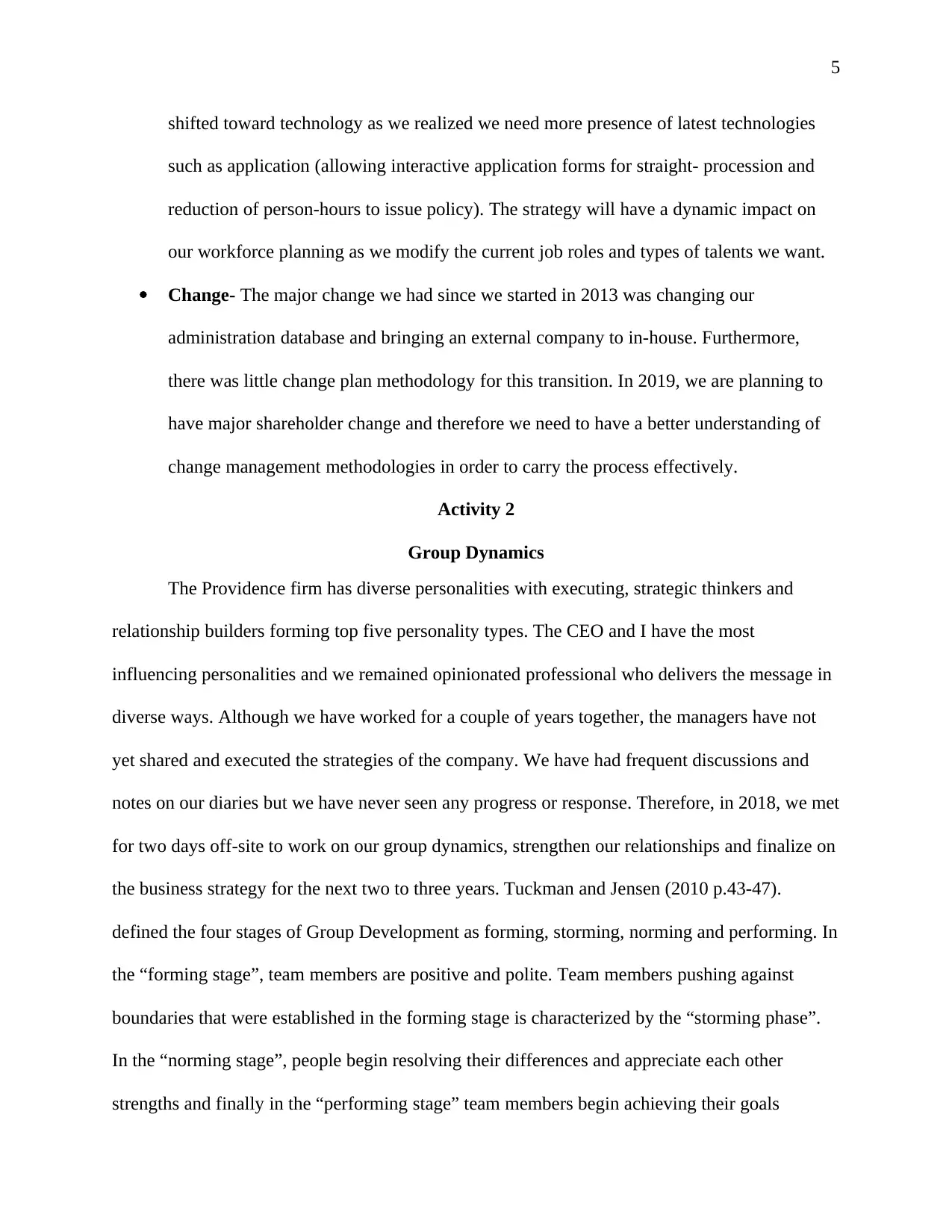
5
shifted toward technology as we realized we need more presence of latest technologies
such as application (allowing interactive application forms for straight- procession and
reduction of person-hours to issue policy). The strategy will have a dynamic impact on
our workforce planning as we modify the current job roles and types of talents we want.
Change- The major change we had since we started in 2013 was changing our
administration database and bringing an external company to in-house. Furthermore,
there was little change plan methodology for this transition. In 2019, we are planning to
have major shareholder change and therefore we need to have a better understanding of
change management methodologies in order to carry the process effectively.
Activity 2
Group Dynamics
The Providence firm has diverse personalities with executing, strategic thinkers and
relationship builders forming top five personality types. The CEO and I have the most
influencing personalities and we remained opinionated professional who delivers the message in
diverse ways. Although we have worked for a couple of years together, the managers have not
yet shared and executed the strategies of the company. We have had frequent discussions and
notes on our diaries but we have never seen any progress or response. Therefore, in 2018, we met
for two days off-site to work on our group dynamics, strengthen our relationships and finalize on
the business strategy for the next two to three years. Tuckman and Jensen (2010 p.43-47).
defined the four stages of Group Development as forming, storming, norming and performing. In
the “forming stage”, team members are positive and polite. Team members pushing against
boundaries that were established in the forming stage is characterized by the “storming phase”.
In the “norming stage”, people begin resolving their differences and appreciate each other
strengths and finally in the “performing stage” team members begin achieving their goals
shifted toward technology as we realized we need more presence of latest technologies
such as application (allowing interactive application forms for straight- procession and
reduction of person-hours to issue policy). The strategy will have a dynamic impact on
our workforce planning as we modify the current job roles and types of talents we want.
Change- The major change we had since we started in 2013 was changing our
administration database and bringing an external company to in-house. Furthermore,
there was little change plan methodology for this transition. In 2019, we are planning to
have major shareholder change and therefore we need to have a better understanding of
change management methodologies in order to carry the process effectively.
Activity 2
Group Dynamics
The Providence firm has diverse personalities with executing, strategic thinkers and
relationship builders forming top five personality types. The CEO and I have the most
influencing personalities and we remained opinionated professional who delivers the message in
diverse ways. Although we have worked for a couple of years together, the managers have not
yet shared and executed the strategies of the company. We have had frequent discussions and
notes on our diaries but we have never seen any progress or response. Therefore, in 2018, we met
for two days off-site to work on our group dynamics, strengthen our relationships and finalize on
the business strategy for the next two to three years. Tuckman and Jensen (2010 p.43-47).
defined the four stages of Group Development as forming, storming, norming and performing. In
the “forming stage”, team members are positive and polite. Team members pushing against
boundaries that were established in the forming stage is characterized by the “storming phase”.
In the “norming stage”, people begin resolving their differences and appreciate each other
strengths and finally in the “performing stage” team members begin achieving their goals
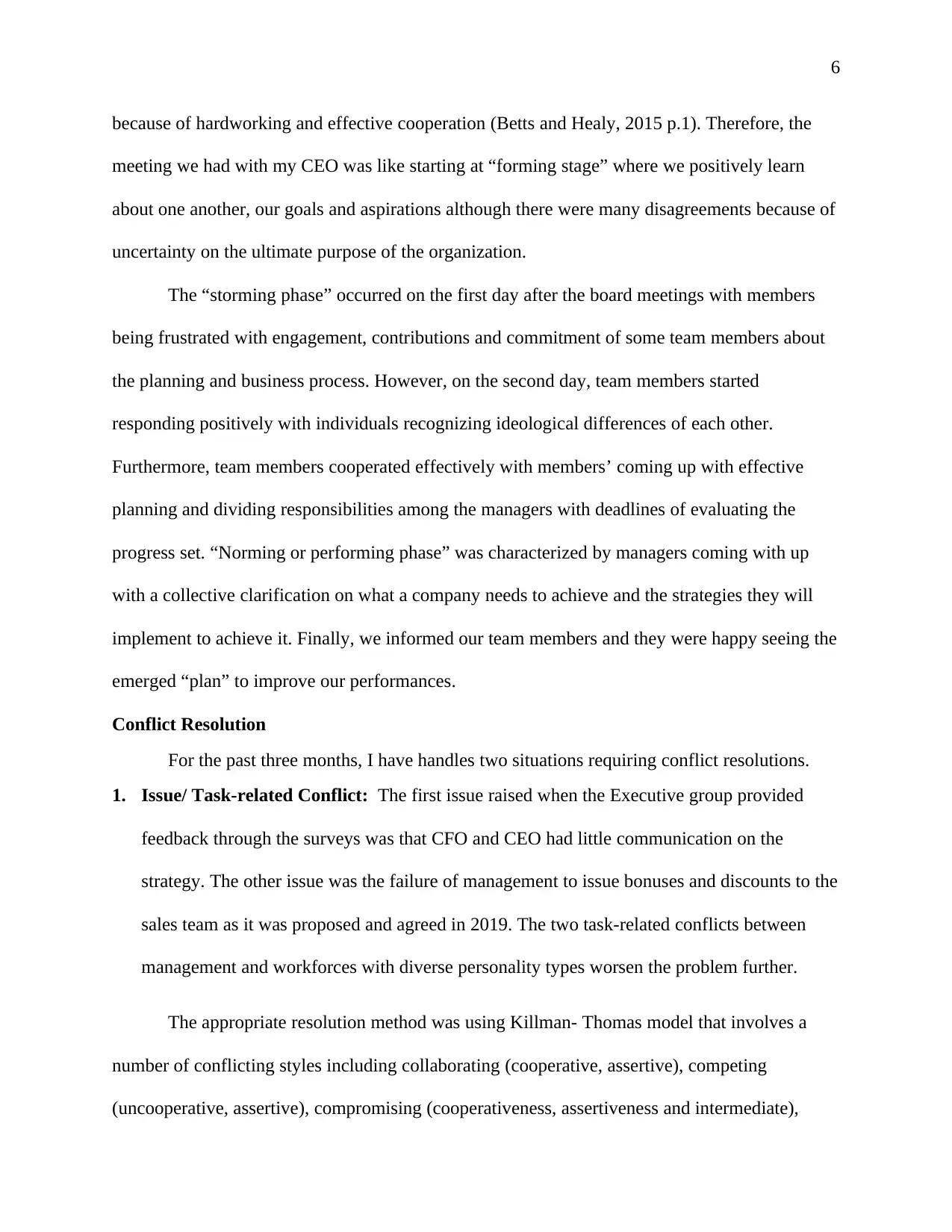
6
because of hardworking and effective cooperation (Betts and Healy, 2015 p.1). Therefore, the
meeting we had with my CEO was like starting at “forming stage” where we positively learn
about one another, our goals and aspirations although there were many disagreements because of
uncertainty on the ultimate purpose of the organization.
The “storming phase” occurred on the first day after the board meetings with members
being frustrated with engagement, contributions and commitment of some team members about
the planning and business process. However, on the second day, team members started
responding positively with individuals recognizing ideological differences of each other.
Furthermore, team members cooperated effectively with members’ coming up with effective
planning and dividing responsibilities among the managers with deadlines of evaluating the
progress set. “Norming or performing phase” was characterized by managers coming with up
with a collective clarification on what a company needs to achieve and the strategies they will
implement to achieve it. Finally, we informed our team members and they were happy seeing the
emerged “plan” to improve our performances.
Conflict Resolution
For the past three months, I have handles two situations requiring conflict resolutions.
1. Issue/ Task-related Conflict: The first issue raised when the Executive group provided
feedback through the surveys was that CFO and CEO had little communication on the
strategy. The other issue was the failure of management to issue bonuses and discounts to the
sales team as it was proposed and agreed in 2019. The two task-related conflicts between
management and workforces with diverse personality types worsen the problem further.
The appropriate resolution method was using Killman- Thomas model that involves a
number of conflicting styles including collaborating (cooperative, assertive), competing
(uncooperative, assertive), compromising (cooperativeness, assertiveness and intermediate),
because of hardworking and effective cooperation (Betts and Healy, 2015 p.1). Therefore, the
meeting we had with my CEO was like starting at “forming stage” where we positively learn
about one another, our goals and aspirations although there were many disagreements because of
uncertainty on the ultimate purpose of the organization.
The “storming phase” occurred on the first day after the board meetings with members
being frustrated with engagement, contributions and commitment of some team members about
the planning and business process. However, on the second day, team members started
responding positively with individuals recognizing ideological differences of each other.
Furthermore, team members cooperated effectively with members’ coming up with effective
planning and dividing responsibilities among the managers with deadlines of evaluating the
progress set. “Norming or performing phase” was characterized by managers coming with up
with a collective clarification on what a company needs to achieve and the strategies they will
implement to achieve it. Finally, we informed our team members and they were happy seeing the
emerged “plan” to improve our performances.
Conflict Resolution
For the past three months, I have handles two situations requiring conflict resolutions.
1. Issue/ Task-related Conflict: The first issue raised when the Executive group provided
feedback through the surveys was that CFO and CEO had little communication on the
strategy. The other issue was the failure of management to issue bonuses and discounts to the
sales team as it was proposed and agreed in 2019. The two task-related conflicts between
management and workforces with diverse personality types worsen the problem further.
The appropriate resolution method was using Killman- Thomas model that involves a
number of conflicting styles including collaborating (cooperative, assertive), competing
(uncooperative, assertive), compromising (cooperativeness, assertiveness and intermediate),
⊘ This is a preview!⊘
Do you want full access?
Subscribe today to unlock all pages.

Trusted by 1+ million students worldwide
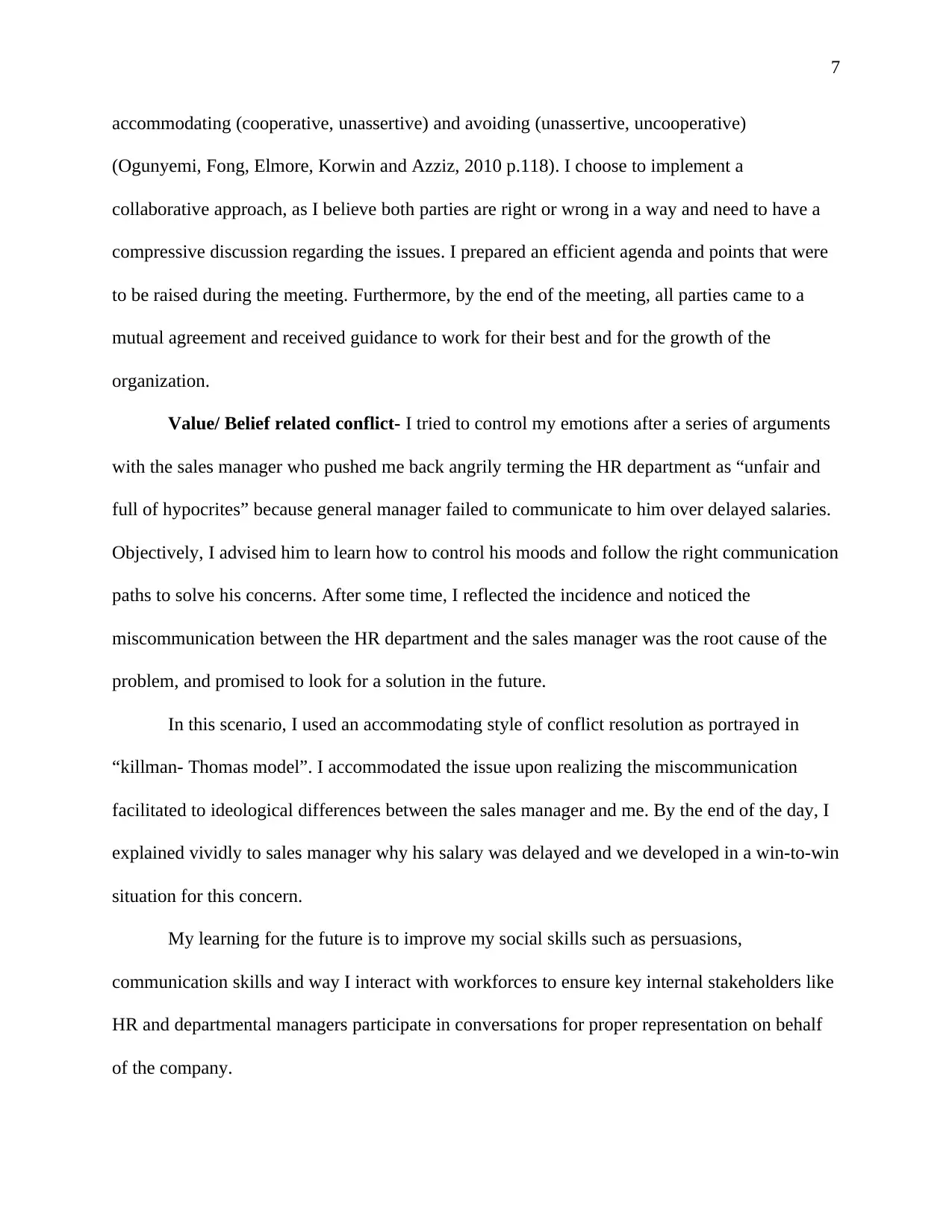
7
accommodating (cooperative, unassertive) and avoiding (unassertive, uncooperative)
(Ogunyemi, Fong, Elmore, Korwin and Azziz, 2010 p.118). I choose to implement a
collaborative approach, as I believe both parties are right or wrong in a way and need to have a
compressive discussion regarding the issues. I prepared an efficient agenda and points that were
to be raised during the meeting. Furthermore, by the end of the meeting, all parties came to a
mutual agreement and received guidance to work for their best and for the growth of the
organization.
Value/ Belief related conflict- I tried to control my emotions after a series of arguments
with the sales manager who pushed me back angrily terming the HR department as “unfair and
full of hypocrites” because general manager failed to communicate to him over delayed salaries.
Objectively, I advised him to learn how to control his moods and follow the right communication
paths to solve his concerns. After some time, I reflected the incidence and noticed the
miscommunication between the HR department and the sales manager was the root cause of the
problem, and promised to look for a solution in the future.
In this scenario, I used an accommodating style of conflict resolution as portrayed in
“killman- Thomas model”. I accommodated the issue upon realizing the miscommunication
facilitated to ideological differences between the sales manager and me. By the end of the day, I
explained vividly to sales manager why his salary was delayed and we developed in a win-to-win
situation for this concern.
My learning for the future is to improve my social skills such as persuasions,
communication skills and way I interact with workforces to ensure key internal stakeholders like
HR and departmental managers participate in conversations for proper representation on behalf
of the company.
accommodating (cooperative, unassertive) and avoiding (unassertive, uncooperative)
(Ogunyemi, Fong, Elmore, Korwin and Azziz, 2010 p.118). I choose to implement a
collaborative approach, as I believe both parties are right or wrong in a way and need to have a
compressive discussion regarding the issues. I prepared an efficient agenda and points that were
to be raised during the meeting. Furthermore, by the end of the meeting, all parties came to a
mutual agreement and received guidance to work for their best and for the growth of the
organization.
Value/ Belief related conflict- I tried to control my emotions after a series of arguments
with the sales manager who pushed me back angrily terming the HR department as “unfair and
full of hypocrites” because general manager failed to communicate to him over delayed salaries.
Objectively, I advised him to learn how to control his moods and follow the right communication
paths to solve his concerns. After some time, I reflected the incidence and noticed the
miscommunication between the HR department and the sales manager was the root cause of the
problem, and promised to look for a solution in the future.
In this scenario, I used an accommodating style of conflict resolution as portrayed in
“killman- Thomas model”. I accommodated the issue upon realizing the miscommunication
facilitated to ideological differences between the sales manager and me. By the end of the day, I
explained vividly to sales manager why his salary was delayed and we developed in a win-to-win
situation for this concern.
My learning for the future is to improve my social skills such as persuasions,
communication skills and way I interact with workforces to ensure key internal stakeholders like
HR and departmental managers participate in conversations for proper representation on behalf
of the company.
Paraphrase This Document
Need a fresh take? Get an instant paraphrase of this document with our AI Paraphraser
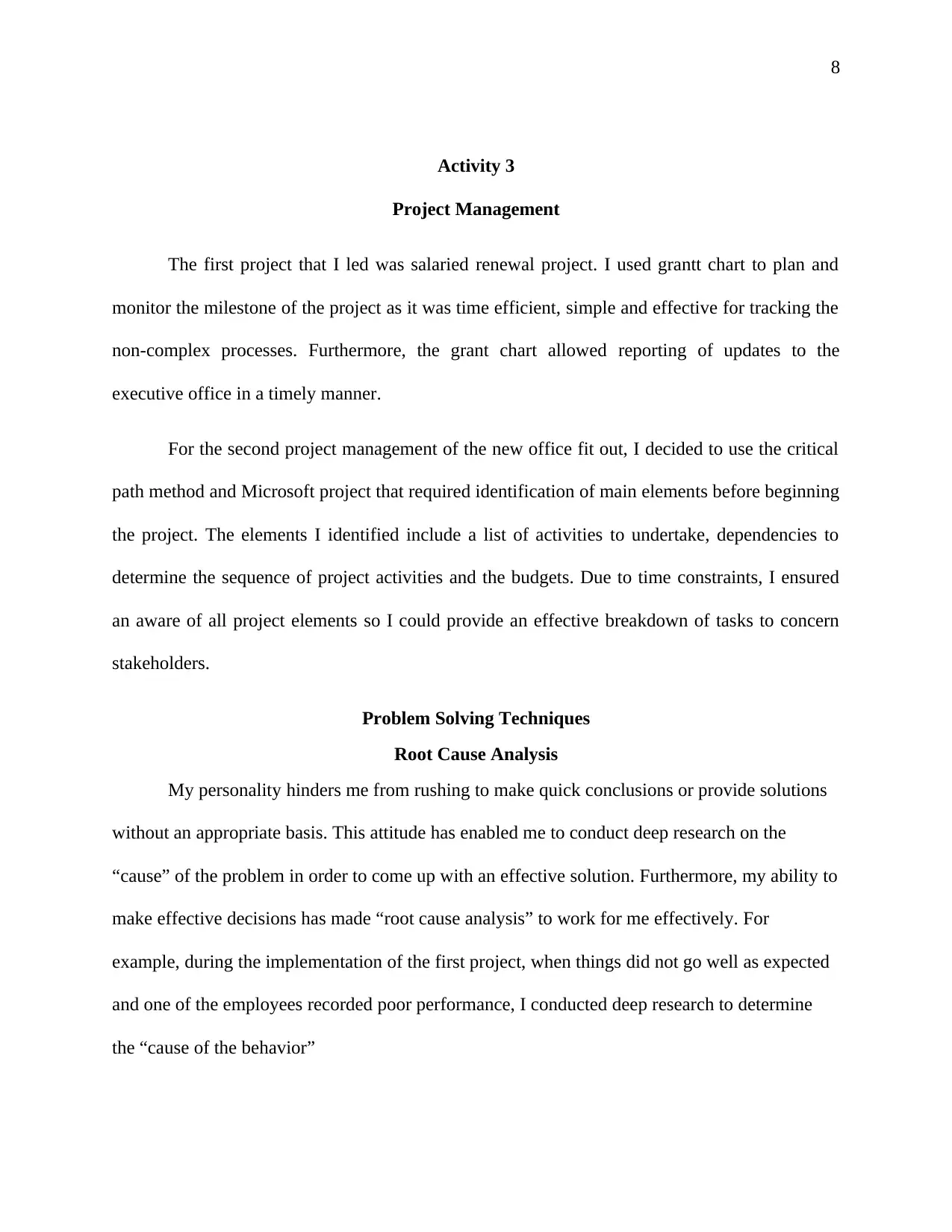
8
Activity 3
Project Management
The first project that I led was salaried renewal project. I used grantt chart to plan and
monitor the milestone of the project as it was time efficient, simple and effective for tracking the
non-complex processes. Furthermore, the grant chart allowed reporting of updates to the
executive office in a timely manner.
For the second project management of the new office fit out, I decided to use the critical
path method and Microsoft project that required identification of main elements before beginning
the project. The elements I identified include a list of activities to undertake, dependencies to
determine the sequence of project activities and the budgets. Due to time constraints, I ensured
an aware of all project elements so I could provide an effective breakdown of tasks to concern
stakeholders.
Problem Solving Techniques
Root Cause Analysis
My personality hinders me from rushing to make quick conclusions or provide solutions
without an appropriate basis. This attitude has enabled me to conduct deep research on the
“cause” of the problem in order to come up with an effective solution. Furthermore, my ability to
make effective decisions has made “root cause analysis” to work for me effectively. For
example, during the implementation of the first project, when things did not go well as expected
and one of the employees recorded poor performance, I conducted deep research to determine
the “cause of the behavior”
Activity 3
Project Management
The first project that I led was salaried renewal project. I used grantt chart to plan and
monitor the milestone of the project as it was time efficient, simple and effective for tracking the
non-complex processes. Furthermore, the grant chart allowed reporting of updates to the
executive office in a timely manner.
For the second project management of the new office fit out, I decided to use the critical
path method and Microsoft project that required identification of main elements before beginning
the project. The elements I identified include a list of activities to undertake, dependencies to
determine the sequence of project activities and the budgets. Due to time constraints, I ensured
an aware of all project elements so I could provide an effective breakdown of tasks to concern
stakeholders.
Problem Solving Techniques
Root Cause Analysis
My personality hinders me from rushing to make quick conclusions or provide solutions
without an appropriate basis. This attitude has enabled me to conduct deep research on the
“cause” of the problem in order to come up with an effective solution. Furthermore, my ability to
make effective decisions has made “root cause analysis” to work for me effectively. For
example, during the implementation of the first project, when things did not go well as expected
and one of the employees recorded poor performance, I conducted deep research to determine
the “cause of the behavior”
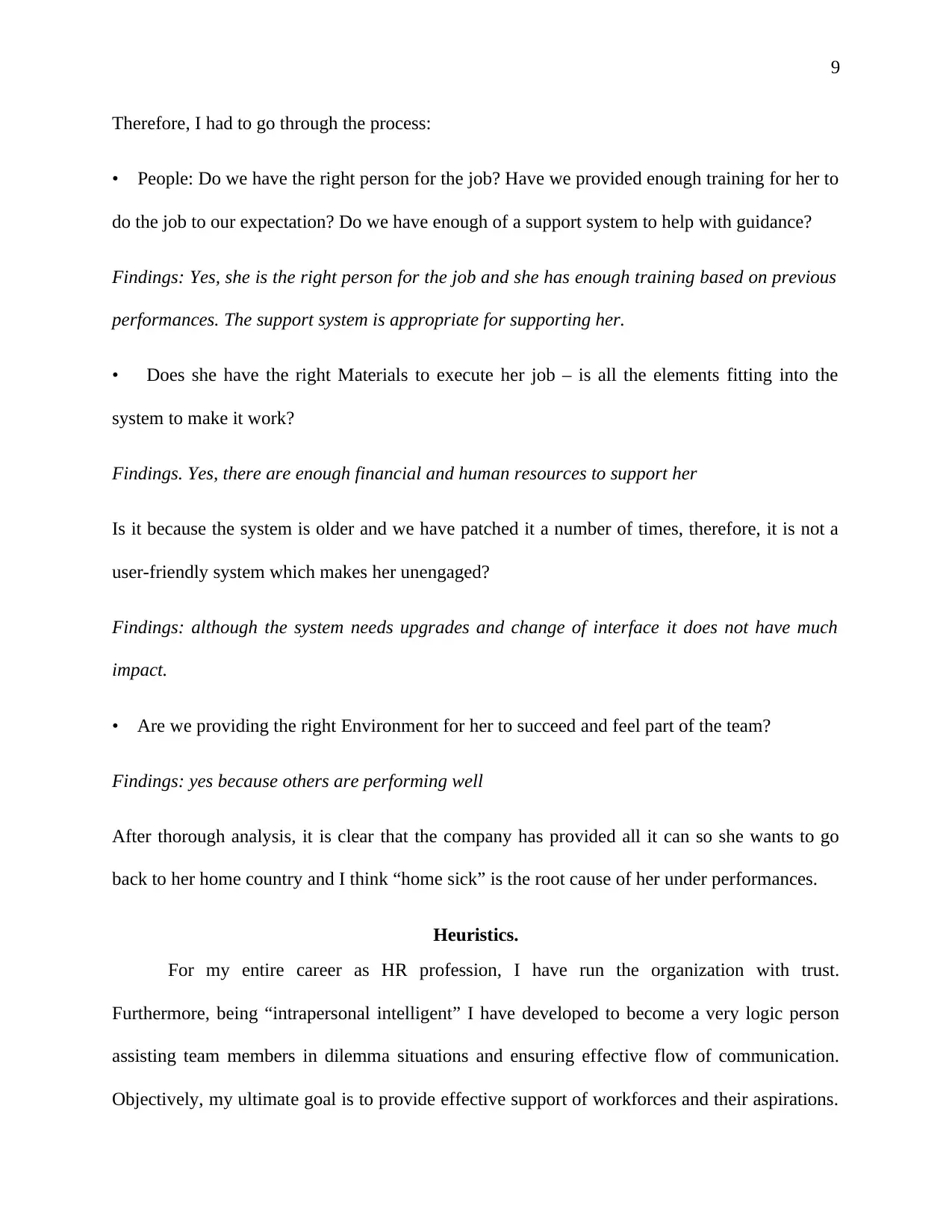
9
Therefore, I had to go through the process:
• People: Do we have the right person for the job? Have we provided enough training for her to
do the job to our expectation? Do we have enough of a support system to help with guidance?
Findings: Yes, she is the right person for the job and she has enough training based on previous
performances. The support system is appropriate for supporting her.
• Does she have the right Materials to execute her job – is all the elements fitting into the
system to make it work?
Findings. Yes, there are enough financial and human resources to support her
Is it because the system is older and we have patched it a number of times, therefore, it is not a
user-friendly system which makes her unengaged?
Findings: although the system needs upgrades and change of interface it does not have much
impact.
• Are we providing the right Environment for her to succeed and feel part of the team?
Findings: yes because others are performing well
After thorough analysis, it is clear that the company has provided all it can so she wants to go
back to her home country and I think “home sick” is the root cause of her under performances.
Heuristics.
For my entire career as HR profession, I have run the organization with trust.
Furthermore, being “intrapersonal intelligent” I have developed to become a very logic person
assisting team members in dilemma situations and ensuring effective flow of communication.
Objectively, my ultimate goal is to provide effective support of workforces and their aspirations.
Therefore, I had to go through the process:
• People: Do we have the right person for the job? Have we provided enough training for her to
do the job to our expectation? Do we have enough of a support system to help with guidance?
Findings: Yes, she is the right person for the job and she has enough training based on previous
performances. The support system is appropriate for supporting her.
• Does she have the right Materials to execute her job – is all the elements fitting into the
system to make it work?
Findings. Yes, there are enough financial and human resources to support her
Is it because the system is older and we have patched it a number of times, therefore, it is not a
user-friendly system which makes her unengaged?
Findings: although the system needs upgrades and change of interface it does not have much
impact.
• Are we providing the right Environment for her to succeed and feel part of the team?
Findings: yes because others are performing well
After thorough analysis, it is clear that the company has provided all it can so she wants to go
back to her home country and I think “home sick” is the root cause of her under performances.
Heuristics.
For my entire career as HR profession, I have run the organization with trust.
Furthermore, being “intrapersonal intelligent” I have developed to become a very logic person
assisting team members in dilemma situations and ensuring effective flow of communication.
Objectively, my ultimate goal is to provide effective support of workforces and their aspirations.
⊘ This is a preview!⊘
Do you want full access?
Subscribe today to unlock all pages.

Trusted by 1+ million students worldwide
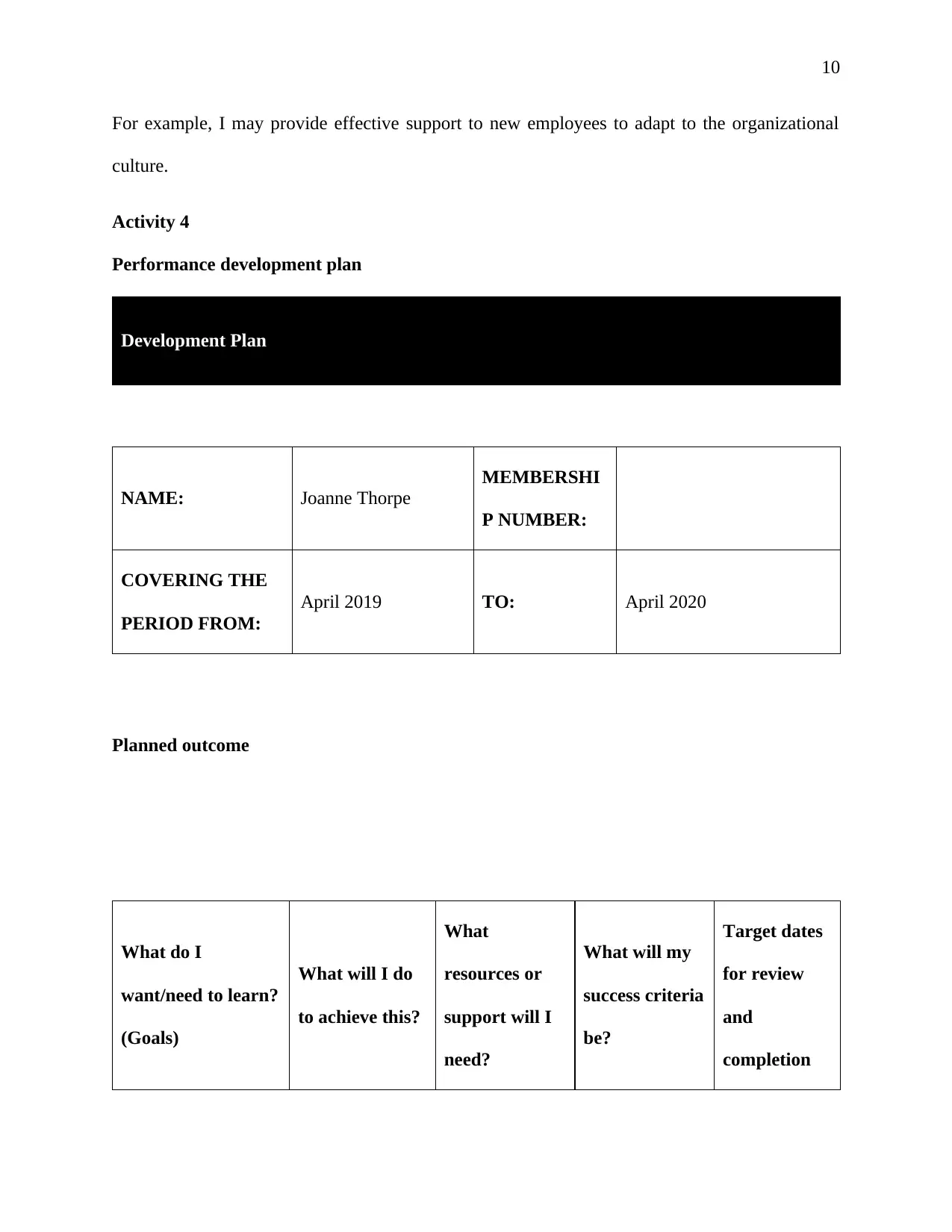
10
For example, I may provide effective support to new employees to adapt to the organizational
culture.
Activity 4
Performance development plan
Development Plan
NAME: Joanne Thorpe
MEMBERSHI
P NUMBER:
COVERING THE
PERIOD FROM:
April 2019 TO: April 2020
Planned outcome
What do I
want/need to learn?
(Goals)
What will I do
to achieve this?
What
resources or
support will I
need?
What will my
success criteria
be?
Target dates
for review
and
completion
For example, I may provide effective support to new employees to adapt to the organizational
culture.
Activity 4
Performance development plan
Development Plan
NAME: Joanne Thorpe
MEMBERSHI
P NUMBER:
COVERING THE
PERIOD FROM:
April 2019 TO: April 2020
Planned outcome
What do I
want/need to learn?
(Goals)
What will I do
to achieve this?
What
resources or
support will I
need?
What will my
success criteria
be?
Target dates
for review
and
completion
Paraphrase This Document
Need a fresh take? Get an instant paraphrase of this document with our AI Paraphraser
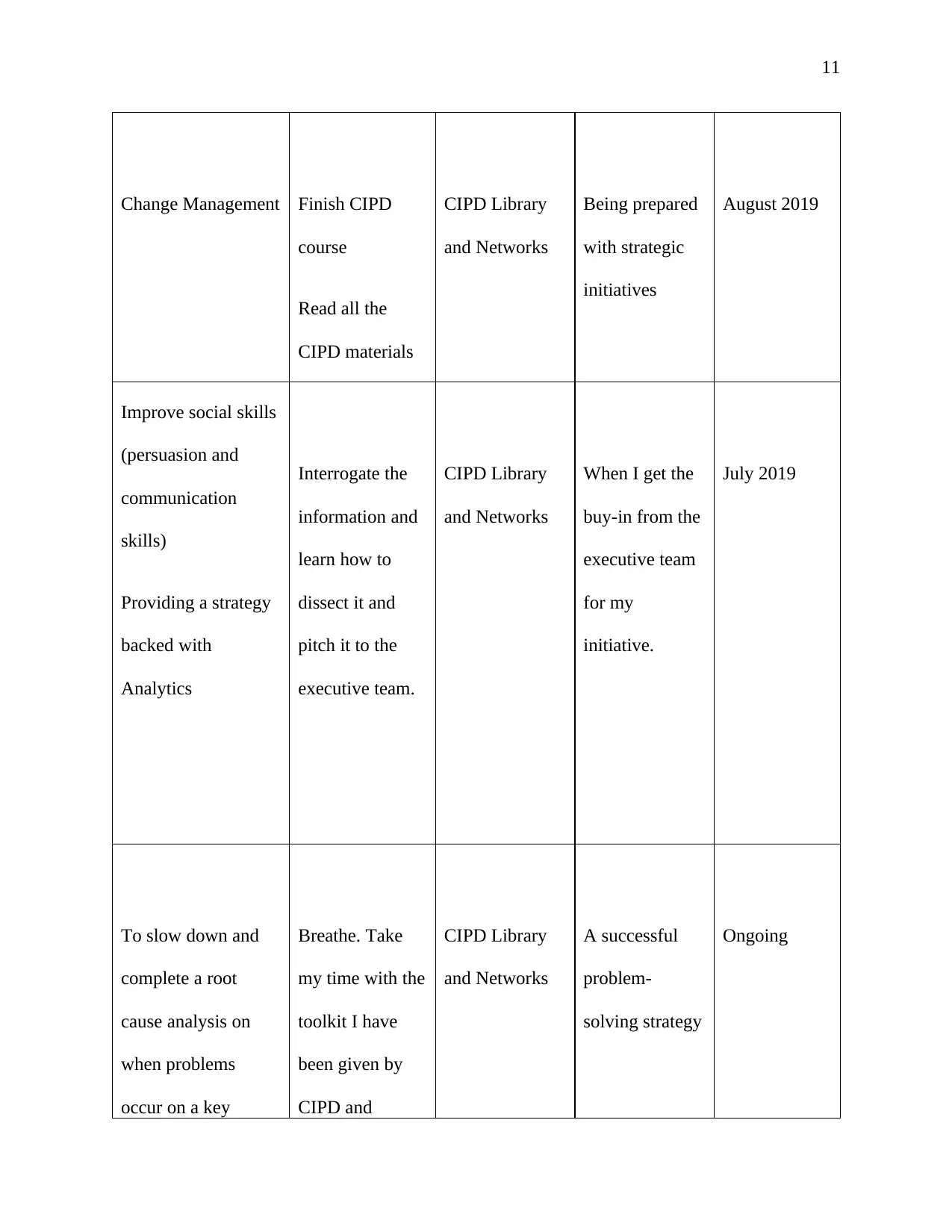
11
Change Management Finish CIPD
course
Read all the
CIPD materials
CIPD Library
and Networks
Being prepared
with strategic
initiatives
August 2019
Improve social skills
(persuasion and
communication
skills)
Providing a strategy
backed with
Analytics
Interrogate the
information and
learn how to
dissect it and
pitch it to the
executive team.
CIPD Library
and Networks
When I get the
buy-in from the
executive team
for my
initiative.
July 2019
To slow down and
complete a root
cause analysis on
when problems
occur on a key
Breathe. Take
my time with the
toolkit I have
been given by
CIPD and
CIPD Library
and Networks
A successful
problem-
solving strategy
Ongoing
Change Management Finish CIPD
course
Read all the
CIPD materials
CIPD Library
and Networks
Being prepared
with strategic
initiatives
August 2019
Improve social skills
(persuasion and
communication
skills)
Providing a strategy
backed with
Analytics
Interrogate the
information and
learn how to
dissect it and
pitch it to the
executive team.
CIPD Library
and Networks
When I get the
buy-in from the
executive team
for my
initiative.
July 2019
To slow down and
complete a root
cause analysis on
when problems
occur on a key
Breathe. Take
my time with the
toolkit I have
been given by
CIPD and
CIPD Library
and Networks
A successful
problem-
solving strategy
Ongoing
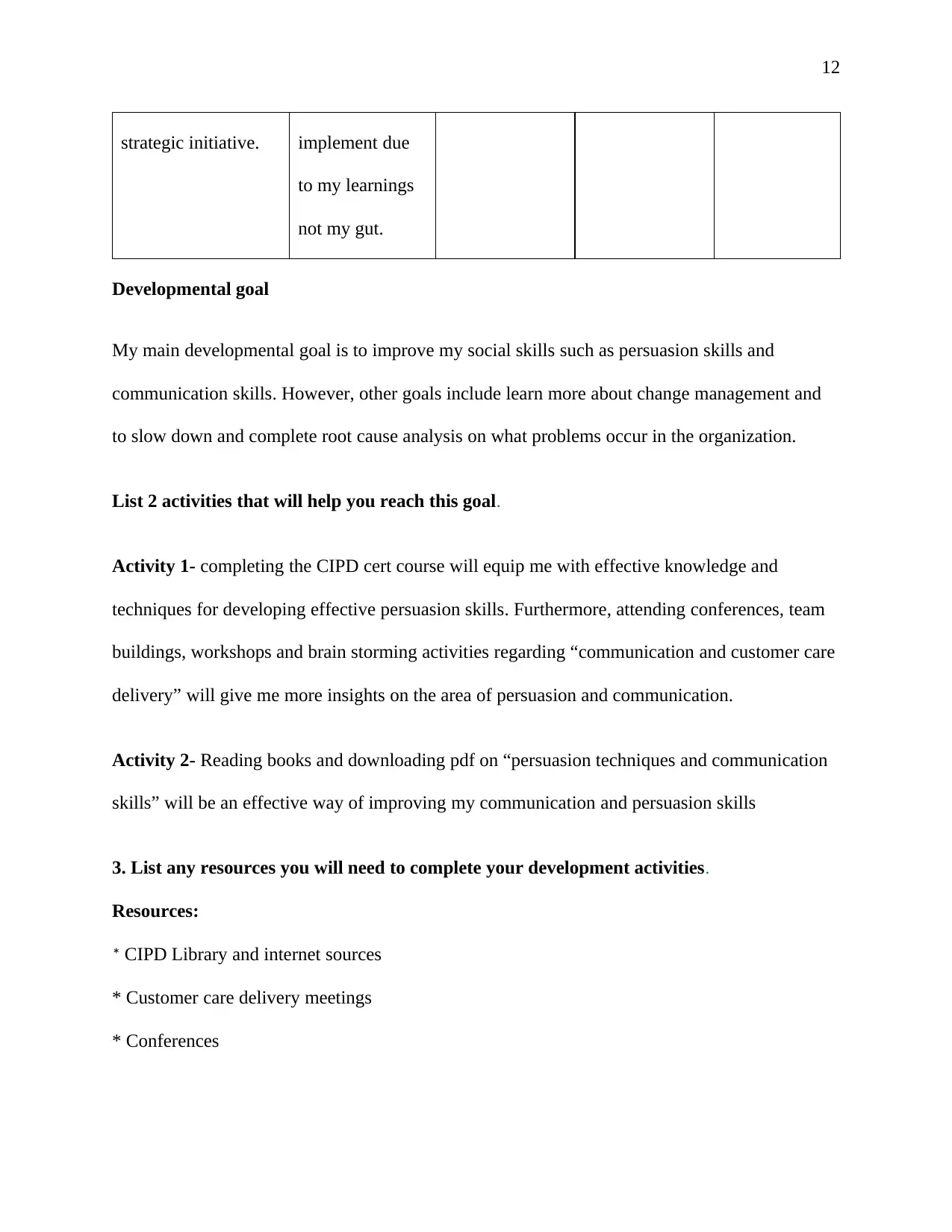
12
strategic initiative. implement due
to my learnings
not my gut.
Developmental goal
My main developmental goal is to improve my social skills such as persuasion skills and
communication skills. However, other goals include learn more about change management and
to slow down and complete root cause analysis on what problems occur in the organization.
List 2 activities that will help you reach this goal.
Activity 1- completing the CIPD cert course will equip me with effective knowledge and
techniques for developing effective persuasion skills. Furthermore, attending conferences, team
buildings, workshops and brain storming activities regarding “communication and customer care
delivery” will give me more insights on the area of persuasion and communication.
Activity 2- Reading books and downloading pdf on “persuasion techniques and communication
skills” will be an effective way of improving my communication and persuasion skills
3. List any resources you will need to complete your development activities.
Resources:
* CIPD Library and internet sources
* Customer care delivery meetings
* Conferences
strategic initiative. implement due
to my learnings
not my gut.
Developmental goal
My main developmental goal is to improve my social skills such as persuasion skills and
communication skills. However, other goals include learn more about change management and
to slow down and complete root cause analysis on what problems occur in the organization.
List 2 activities that will help you reach this goal.
Activity 1- completing the CIPD cert course will equip me with effective knowledge and
techniques for developing effective persuasion skills. Furthermore, attending conferences, team
buildings, workshops and brain storming activities regarding “communication and customer care
delivery” will give me more insights on the area of persuasion and communication.
Activity 2- Reading books and downloading pdf on “persuasion techniques and communication
skills” will be an effective way of improving my communication and persuasion skills
3. List any resources you will need to complete your development activities.
Resources:
* CIPD Library and internet sources
* Customer care delivery meetings
* Conferences
⊘ This is a preview!⊘
Do you want full access?
Subscribe today to unlock all pages.

Trusted by 1+ million students worldwide
1 out of 14
Related Documents
Your All-in-One AI-Powered Toolkit for Academic Success.
+13062052269
info@desklib.com
Available 24*7 on WhatsApp / Email
![[object Object]](/_next/static/media/star-bottom.7253800d.svg)
Unlock your academic potential
Copyright © 2020–2025 A2Z Services. All Rights Reserved. Developed and managed by ZUCOL.





